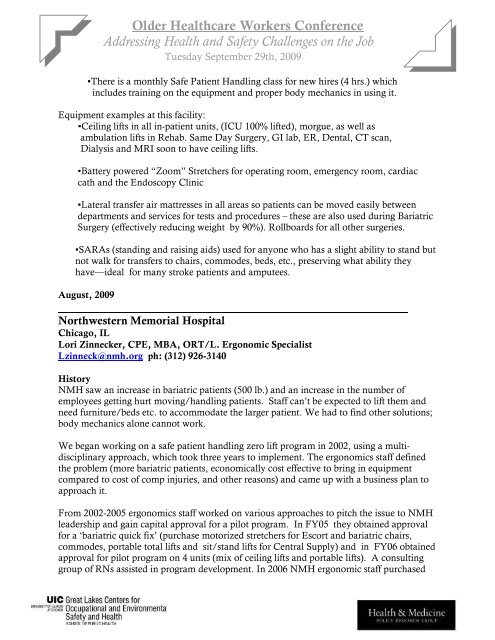Employer Case Examples - Health & Medicine Policy Research Group
Employer Case Examples - Health & Medicine Policy Research Group
Employer Case Examples - Health & Medicine Policy Research Group
You also want an ePaper? Increase the reach of your titles
YUMPU automatically turns print PDFs into web optimized ePapers that Google loves.
Older <strong>Health</strong>care Workers ConferenceAddressing <strong>Health</strong> and Safety Challenges on the JobTuesday September 29th, 2009▪There is a monthly Safe Patient Handling class for new hires (4 hrs.) whichincludes training on the equipment and proper body mechanics in using it.Equipment examples at this facility:▪Ceiling lifts in all in-patient units, (ICU 100% lifted), morgue, as well asambulation lifts in Rehab. Same Day Surgery, GI lab, ER, Dental, CT scan,Dialysis and MRI soon to have ceiling lifts.▪Battery powered “Zoom” Stretchers for operating room, emergency room, cardiaccath and the Endoscopy Clinic▪Lateral transfer air mattresses in all areas so patients can be moved easily betweendepartments and services for tests and procedures – these are also used during BariatricSurgery (effectively reducing weight by 90%). Rollboards for all other surgeries.▪SARAs (standing and raising aids) used for anyone who has a slight ability to stand butnot walk for transfers to chairs, commodes, beds, etc., preserving what ability theyhave—ideal for many stroke patients and amputees.August, 2009Northwestern Memorial HospitalChicago, ILLori Zinnecker, CPE, MBA, ORT/L. Ergonomic SpecialistLzinneck@nmh.org ph: (312) 926-3140HistoryNMH saw an increase in bariatric patients (500 lb.) and an increase in the number ofemployees getting hurt moving/handling patients. Staff can’t be expected to lift them andneed furniture/beds etc. to accommodate the larger patient. We had to find other solutions;body mechanics alone cannot work.We began working on a safe patient handling zero lift program in 2002, using a multidisciplinaryapproach, which took three years to implement. The ergonomics staff definedthe problem (more bariatric patients, economically cost effective to bring in equipmentcompared to cost of comp injuries, and other reasons) and came up with a business plan toapproach it.From 2002-2005 ergonomics staff worked on various approaches to pitch the issue to NMHleadership and gain capital approval for a pilot program. In FY05 they obtained approvalfor a ‘bariatric quick fix’ (purchase motorized stretchers for Escort and bariatric chairs,commodes, portable total lifts and sit/stand lifts for Central Supply) and in FY06 obtainedapproval for pilot program on 4 units (mix of ceiling lifts and portable lifts). A consultinggroup of RNs assisted in program development. In 2006 NMH ergonomic staff purchased


